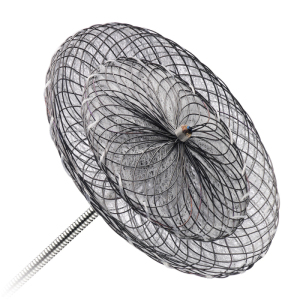by
Gail Kalinoski, Contributing Reporter | June 01, 2016

Would be first transcatheter
patent foramen ovale (PFO)
closure device Courtesy:
St. Jude Medical
A controversial PFO closure device manufactured by St. Paul, Minn.-based St. Jude Medical that could help heart patients avoid strokes has been given premarket approval by experts participating in an FDA panel to determine if the device is safe and effective.
If approved, it would be the first transcatheter patent foramen ovale (PFO) closure device. The Amplatzer PFO Occluder is designed to prevent recurrent ischemic strokes in patients with PFO.
Patients with PFO who have suffered strokes are generally put on blood thinners for the rest of their life. The wire mesh device would cover a hole, or PFO, between the upper chambers of the heart. It is designed to seal the hole to prevent blood clots from crossing between the upper chambers of the heart and getting to the brain.



Ad Statistics
Times Displayed: 2639
Times Visited: 16 Fast-moving cardiac structures have a big impact on imaging. Fujifilm’s SCENARIA View premium performance CT brings solutions to address motion in Coronary CTA while delivering unique dose saving and workflow increasing benefits.
Larry Biegelson, a Wells Fargo analyst,
told the Star Tribune that PFO Closure devices were “one of the most controversial areas of cardiovascular devices/medicine over the past 10-plus years, with strong proponents and equally strong critics.”
The wire mesh device costs an estimated $5,000 each and could bring in between $200 million and $300 million a year for St. Jude Medical, the newspaper stated. St. Jude Medical is in the process of
being acquired by Abbott Laboratories for $25 billion.
On May 24 doctors on the FDA’s Circulatory System Devices Panel voted 15 to 1 that it was safe to use. The panel voted 9 to 7 on its effectiveness and 11 to 5 on whether the potential benefits outweigh the risk,
according to a report by TCTMD.
The device was tested in the RESPECT trial. Conducted over 13 years by AGA Medical, which invented the device and was later bought by St. Jude Medical, the study followed 980 patients, who had to be tracked for five years each after the enrollment period which lasted eight years, according to the Star Tribune. The FDA noted that the trial did document a lower rate of stroke among those who got the device, but overall failed to meet its primary endpoint.
St. Jude Medical, though, stated the studies showed a 54 percent risk reduction in recurrent stroke with those using the device, compared to those only using blood thinners. The company also noted that 4.5 percent of patients with the device had adverse reactions.
After the FDA panel debate, the bottom line seemed to be that most of the experts felt the device should be made available for patients. The FDA doesn’t have to follow the recommendation of expert panels, but generally does.

